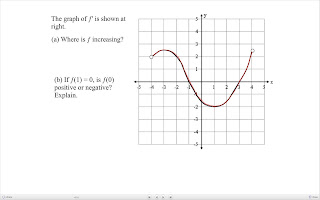
Mr. K then asked us when was the car moving fastest. The class decided that the car was moving fastest during t2, because the slope of the tangent line was the steepest at that point. During the interval [t1,t2], it is clear that the car is speeding up during that interval because the slope of the tangent lines are getting steeper going from t1 to t2. The car is definitely slowing down on the interval [t2,t3] as we can see that the slope of the ! tangent lines are decreasing.

Now this was a tough graph to decipher. The AP Calculus students had no problem understanding this one, but to those of us who aren't taking AP, this was kind of difficult. I myself found it quite confusing at first, but after clarification, I understand it. Now, you have to find the derivative of f in this graph to find out where is f ' is positive. First we have to find out where the tangent lines in f are zero. Looking at the ! function f, we can cl! early se e that the tangent lines are zero in -2 and +2. This means that f ' will have roots at -2 and +2. Then, we look when the tangent lines of f are approaching zero. There are 2 instances in this graph. The first instance is from (-∞, -2]. The slope from that domain is increasing, since it's coming from a negative value to zero. But that still doesn't solve our problem since f ' is still negative at that point. Then, from (-2, 2) in f, we can see that the slope is increasing until (0,0) and it starts to decrease until it reaches (! 2,3), where it becomes zero. At this point, f ' is positive as the slopes of the tangent lines from (-2, -1) to (0,0) are increasing from zero and reaches its maximum at (0,0), and then it starts to decrease from (0,0) until it reaches (2,3) where the slope is zero. This then solves the first question which asks where is f ' positive, which is from (-2, o) to (2,0).
Now to find out where f '' is positive. From the graph, we can see that f is some kind of a cubic function, so we know that its derivative will be a quadratic function. Now, the derivative of a quadratic function is a straight line, so now we know that f '' is a straight line. Looking at the shape of f ' (say it is -2x2), it is definitely a negative quadratic function because it has a maximum, not a minimum. We then h! ave to find out the derivative of f '' which is represented as -2x2 (However, it IS NOT -2x2, it's just a representation). Using the power rule, we can determine that the derivative of f ', which is f '', is -4x. From this we can see that the function is positive at quadrant 2.
The critical numbers (which is another term for the roots) of f are -2 and 2.

This is a little difficult...
For a! ), f is increasing w! herever f ' is positive.
For b), f(0) is negative.
Well, that was all we talked about last class. Mr. K tried to squeeze in one more slide but we ran out of time.
The next scribe is Kristin.
Applications of Derivatives Problems
No comments:
Post a Comment